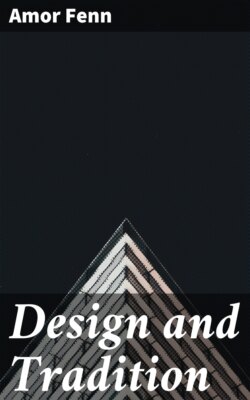Design and Tradition

Реклама. ООО «ЛитРес», ИНН: 7719571260.
Оглавление
Amor Fenn. Design and Tradition
Design and Tradition
Table of Contents
CHAPTER I. INTRODUCTORY
Human Limitations
“Inspiration”
Process and Material
Early Training
Art and Existence
“Natural Taste”
Commercial Production
“Ornaments”
Modern Development
Public Apathy
Elementary Pattern
Early Impressionism
Personal Production
Early Social Conditions
Influence
Commercial Intercourse
Effect on Design
Ethical Side of Art
Desire for Novelty
CHAPTER II. HISTORIC REVIEW
Style
Inter-Communication
Climate and Material
Phases in Style
The Lintel
The Arch
Egyptian
Chaldean
Greek
Roman
Vaulting
Greek Influence
Development of Ornament
Græco-Roman Painted Decoration
Domes
Early Christian Art
Metal Work and Enamel
Roman Influence Abroad
Romanesque Style
Church Development
Dark Ages
Crusades
Pointed Arch
Gothic Style
Phases of Gothic
Early Pointed
Decorated Gothic
Perpendicular Gothic
Glass Windows
Civic Influences
Effect of Commerce
Italy
Foreign Influence in England
The House
The Reformation
Renaissance
Early Exponents
Rome
Venice
Venetian Influence
Painted Decoration
Græco-Roman Influence
Early French Renaissance
Native Exploitation
English Renaissance
Italians in England
Study of Classic Style
Thomas Thorpe
Flemish Influence
Jacobean
Development in Dwellings
Evolution of Professional Designer
Inigo Jones
Louis XIII
Louis XIV
"Boule” Work
Mirrors
Louis XV
Régence
Rococo
Lacquer “Vernis Martin"
Later English Renaissances
Sir Christopher Wren
Classic Spires
Dutch and French Influences
Queen Anne Period
Early Georgian
Chippendale
Mayhew
Adam Style
Hepplewhite
Sheraton
Louis XVI
Riesener and Gouthière
Empire
Empire in England
Later English Architecture
French Influence on Europe
CHAPTER III. MOULDINGS
Purpose
The Fillet
Sheltering Mouldings
The Cavetto
Cyma Recta
Bracketing Mouldings
The Ovolo
Cyma Reversa
Binding Mouldings
The Torus
The Scotia
The Facia
Decoration of Mouldings
Orthodox Details
Angle Leaf
Dentils
Employment
Attitude
Wood Panelling
Applied Mouldings
Bolection Moulding
Plaster
Wood-turning
Metal Turning
Pottery
Metal Mouldings
Wrought Iron
Silver-work
Spinning
Repoussé
CHAPTER IV. ARCHITECTURAL PROPORTIONS
Introduction
System of Proportion
The Order
Doric Order
Ionic Order
Corinthian Order
Doric Entablatures
Mutules
Ionic Entablature
Corinthian Entablature
The Column—The Shaft
The Capital
Doric Capital
Ionic Capital
To Draw the Volute
Corinthian Capital
The Base
Doric Base
Ionic Base
Corinthian Base
The Arch
Doric Impost
Archivolt
Ionic Impost
Ionic Archivolt
Corinthian Impost
Corinthian Archivolt
The Keystone
The Pedestal
Doric Pedestal
Ionic Pedestal
Corinthian Pedestal
The Baluster
Spacing of Balusters
Balustrading
Use of Columns
Disposition and Spacing in Colonnades
Orders Above Orders
The Pilaster
Arcades
Subsidiary Order
Superimposed Orders
Rustication
Basement
Attic
The Pediment
Doors
Windows
CHAPTER V. DIVISION OF SURFACE
Wall Treatment
Ceilings
Jacobean
Carolean and Georgian
Adam Ceilings
Vaults and Domes
The Cove
The Frieze
Borders
Geometric Elements
The Undulate Line
Repetition and Alternation
Treatment of Angles
Pilaster Treatment
Panelled Pilasters
Capitals and Bases
Treatment of Panels
Juxtaposition
The Growth Line
Grouping and Massing
Division of Area
Human and Animal Life
Forms in the Round
Supports and Balusters
Standards
Proportion
Positions for Decoration
Working Drawings
The Segment or Stretch Out
CHAPTER VI. DEVELOPMENT OF CONVENTIONAL ORNAMENT
Outline Drawing
Undesirable Realism
Craft Restrictions
Materialistic Influence
Early Renderings
The Anthemion
Greek Sculptured Ornament
Acanthus Leaf
Roman Development
The Scroll
Græco-Roman
Byzantine
Romanesque
Italian Renaissance
The Husk Leaf
The Rosette
Tendrils
Nature Influence
Symbolic Employment
Consistency in Growth
Branching
Leaves
The Start
Renaissance Influence
Jacobean
Régence
Rococo
Louis XVI
Grinling Gibbons School of Carving
Adam Style
Empire
System of the Acanthus Leaf
CHAPTER VII. TREATMENT IN DESIGN
Natural Attraction
Decorative Materials
Justification of Treatment
Undesirable Imitation
Technical Considerations
Methods of Expression
Treatment of Leaves
Surface Interest
Painted Decoration
Stencilled Work
Mechanical Production, Printed and Woven
Needlework
Appliqué
Lace
Wood Inlay
Intarsia
Veneer, Marquetry
Boule Work
Mosaic
Byzantine Use of Marble
Book Decoration
Bindings
Relief—Economic Result of Method
Desirable Treatment in Carving
Backgrounds
Reproduction Processes
Metal Repoussé
Metal, Cast
Character of Cast Work
CHAPTER VIII. MYTHOLOGY AND SYMBOLISM
Early Symbolic Ornament
Customs
Origin of Mythology
Nature Myths
Light and Darkness
Melanesian Myth
Darkness as a Devouring Monster
Season Myths
Sun Myths
Belief in Natural Phenomena
Greek and Roman Deities
Scandinavian Mythology
Rising and Setting Symbolised
Winds Personified
Predestination
The Fates
Propitiation and Sacrifice
Early Burial Customs
Taboo
Roman Lares
Typical Legend
Early Spiritual Belief
Prehistoric Treatment of Epileptics
Prohibition
Belief in Magical Qualities
The Shirt of Nessus
Swords
Invulnerability
Belief in Numbers
Muses
Sacred Trees and Flowers, etc
Sacred Animals
Evangelist Symbols
The Serpent
The Dragon
Poetic License in Tradition
Animals in Christian Art
Association of Human and Animal Qualities
Totemism
Cannibalism
The Sphinx
Assyrian Winged Monsters
Pegasus
The Harpy
Sirens
Pan
The Nymphs
Centaur
The Circle
Symbols of the Trinity
The Wand a Symbol of Authority
The Hand
The Caduceus
Thyrsus
The Trident
The Cross
The Pastoral Staff
Symbols of Martyrdom
Symbolism of Gems, etc
Masks
Symbols of Time
Secular Symbols
Trophies
Heraldry
Heraldry in Design
Symbolism in Modern Art
Present Apathy
CHAPTER IX. WAYS AND MEANS
Perception
Accepted Conventions
Influence of Fashion
Harmonious Consistency
Natural Suggestion
Colour Scheme
Early Training
Nature Study
Aspect and Attitude
Treatment
Drawings for Reproduction
Opaque Colour
Enlarging and Reducing
Textiles
Wallpapers
Architectural Drawings
Structural Design
Lucid Arrangement
Mathematical Equipment
Use of the Ruling Pen
Proportional Compass
Tracings
Conclusion
INDEX
Отрывок из книги
Amor Fenn
A short account of the principles and historic development of architecture and the applied arts
.....
Jacobean
Carolean and Georgian
.....